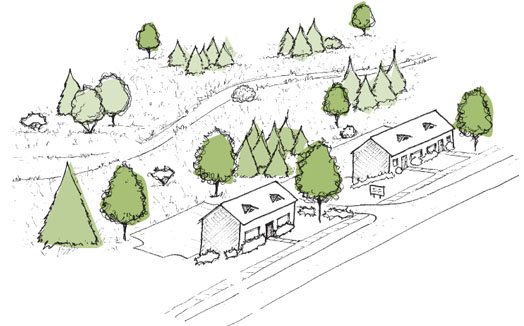|
 |
Natural Landscape Character
Farms, pastures, orchards, vineyards, and expansive forests cover our region’s great dunes and ridges. Interwoven among the lands are numerous lakes, rivers, and streams. The area’s waters and lands drive the economy and contribute to citizenry’s sense of identity. Protection of our natural landscape character is critical to ensuring the continued environmental and economic vitality of the ten-county region. Developments designed for specific conditions can help protect and enhance the region’s natural and manmade character. A building’s or development’s design and location should reflect a site’s topography, natural features, and sensitive areas.
|
|

|
|
Preserving Sensitive Areas
To preserve wetlands, wildlife habitats, woods, and steep slopes, buildings and other improvements should be located on a site’s least environmentally sensitive land. In some cases, local jurisdictions may relax setback requirements to allow for the preservation of a site’s natural features.
|
|
|
Natural Features
Buildings and other improvements should be integrated into a site’s natural landscape with mature trees, especially large stands of trees, maintained to the greatest extent possible. Refer to Critical Design Practices: Scenic Views & Development, Open Space, and Water Resource Protection for additional information.
|
|
|
Topography
Development on sloping or hilly sites requires great care and restraint. Consideration should be given to the preservation and enhancement of the larger area surrounding a site. Hilltops and valleys, bluffs and dunes form integral parts of many of our treasured vistas and natural areas. Sensitive development of these areas is critical to maintaining the natural character of the region.
|
|
|
Key Points:
- Encourage the construction of buildings designed to fit into sloping sites with minimal alteration of the topography and natural vegetation. Minimizing grade changes protects not only a site’s natural character but also soil, vegetation, and water. Incorporating topography into the building design and site layout provides opportunities for grade-level access to multiple floors and reduces the perceived size of the building.
- While federal, state, and local ordinances dictate the preservation of various sensitive ecosystems, the following guidelines provide a general foundation for protecting the region’s sensitive areas: avoid sites with severe slopes of twenty (20) percent or greater, as well as site improvements which necessitate extensive grade changes, and protect natural areas during construction by prohibiting the storage of building materials or equipment in sensitive areas.
|
|
